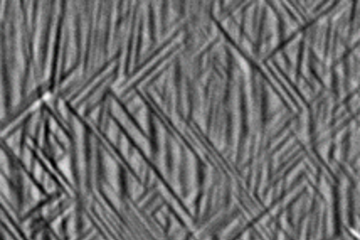All genres
601.
Talk
New insights in the atomic interface structure of kappa carbides in high-Mn steels. TMS2017, San Diego, CA, USA (2017)
602.
Talk
Analysing the effect of milling intensity on the nano-precipitate evolution in ODS FeCrAl alloys using atom probe tomography. MRS Fall Meeting , Boston, MA, USA (2017)
603.
Talk
Degradation Mechanism of Molds for Precision Glass Molding. Microscopy & Microanalysis 2017 Conference, St. Louis, MO, USA (2017)
604.
Talk
Materials for energy generation probed at the nanoscale. European Energy Resarch Alliance Conference 2016, EERA, Birmingham, UK (2016)
605.
Talk
Ab-Initio Guided Design of Twinning Induced Plasticity and Weight Reduced Austenitic Steels. MRS Fall Meeting, Boston, MA, USA (2016)
606.
Talk
Segregation Engineering - Solute Decoration, Complexions and Transformations for Self-Organized Metallurgical Bulk Nanostructures. MRS Fall Meeting, Boston, MA, USA (2016)
607.
Talk
Correlative Atom Probe Microscopy: Recent Progress and Possibilities. European APT Workshop, St Catherine College, Oxford, UK (2016)
608.
Talk
Full determination of 3D atomic position by combining APT & EM. Scientific Directions for Future TEM, Forschungszentrum Jülich, Jülich, Germany (2016)
609.
Talk
Atoms, ions, electrons: simulated, measured and manipulated. Workshop on Scientific Directions for Future Transmission Electron Microscopy, Jülich, Germany (2016)
610.
Talk
Atom probe microscopy: a new playground for big data analysis? Workshop Big-Data-Driven Materials Science, Ringberg Castle, Rottach, Germany (2016)
611.
Talk
Chemo-Mechanics at Lattice Defects: from Mechanisms to Bulk Alloys. Gordon Research Conference on Thin Film & Small Scale Mechanical Behavior, Lewiston, ME, USA (2016)
612.
Talk
A perspective on the ion projection in field ion & atom probe microscopy. Atom Probe Tomography & Microscopy 2016, Gyeongju, South Korea (2016)
613.
Talk
Defect Segregation studied by Correlative Atom Probe Tomography and Electron Microscopy. Japan-Germany Joint Symposium on Advanced Characterization of Nanostructured Materials for Energy and Environment, Conference Center Mutterhaus, Düsseldorf, Germany (2016)
614.
Talk
Atomic diffusion induced degradation in bimetallic layer coated cemented tungsten carbide. APT & M 2016 Conference, Gyeongju, Korea (2016)
615.
Talk
Segregation engineering for self-organized nanostructuring of materials - from atoms to properties? APT&M 2016 - Atom Probe Tomography & Microscopy 2016 (55th IFES) , Gyeongju, South Korea (2016)
616.
Talk
Study of the formation and effect of nano-sized Cu-Sn-Se compounds in Cu2ZnSnSe4 thin-films on solar cell efficiency. Atom Probe Tomography & Microscopy (APT&M) , Gyeongju, South Korea (2016)
617.
Talk
Atom probe tomography study of the phase change material GeTeSe. Atom Probe Tomography & Microscopy (APT&M) , Gyeongju, South Korea (2016)
618.
Talk
From grains to atoms: ping-pong between experiment and simulation for understanding microstructure mechanisms. Res Metallica Symposium, Department of Materials Engineering, KU Leuven, Leuven, The Netherlands (2016)
619.
Talk
Interstitial Compositionally Complex Alloys with Transformation and Twinning Induced Plasticity. 2016 MRS Fall Meeting, Boston, MA, USA (2016)
620.
Talk
Atomistic understanding of structure and deformation of nano-sized kappa-carbide precipitates in light-weight steels. APT&M 2016, The 55th International Conference on Atom Probe Tomography & Microscopy, Gyeongju, South Korea (2016)











